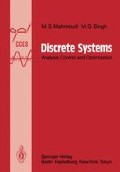Abstract
The past few years have seen significant advances in computer technology and its incorporation into engineering and other applications. In these applications, the various signals acting in and on systems occur as data sequences occurring at discrete time instants. Some familiar examples of systems controlled by discrete data sequences are:
-
1.
National Economies
-
2.
Radar-tracking systems
-
3.
Data-transmission links
We note that in such systems the information is available only in samples. In this chapter we present methods for the analysis of systems incorporating digital devices, which are called discrete-time systems. As used here, the term discrete system refers to any system whose operation or output is conveniently described on a discrete time scale even though the system characteristics may in general be given in continuous time.
Access this chapter
Tax calculation will be finalised at checkout
Purchases are for personal use only
Preview
Unable to display preview. Download preview PDF.
References
Jury, E.I. “Sampled-Data Control Systems”, Wiley, New York, 1958.
Cadzow, J.S. and H.R. Martens “Discrete-Time and Computer Control Systems”, Prentice-Hall, New Jersey, 1970.
Jury, E.I. “Theory and Application of the Z-Transform Method”, Wiley, New York, 1964.
Ragazzini, J.R. and G.F. Franklin “Sampled-Data Control Systems”, McGraw-Hill, New York, 1958.
Tou, J.T. “Digital and Sampled-Data Control Systems”, McGraw-Hill, New York, 1959.
Churchill, R.V. “Introduction to Complex Variables and Applications”, McGraw-Hill, New York, 1948.
Kuo, B.J. “Analysis and Synthesis of Sampled-Data Control Systems”, Prentice-Hall, New Jersey, 1963.
Kaplan, W. “Advanced Calculus”, Addison-Wesley, Cambridge, 1952.
Shinners, S.M. “Control System Design”, Wiley, New York, 1964.
Jury, E.I. “A Simplified Stability Criterion for Linear Discrete Systems”, Proc. IRE, Vol. 50, pp. 1493–1500, 1962.
Jury, E.I. and J. Blanchard, “A Stability Test for Linear Discrete Systems in Table Form”, Proc. IRE, Vol. 49, pp. 1947–1948, 1961.
Mahmoud, M.S. and M.G. Singh “Large-Scale Systems Modelling”, Pergamon Press, Oxford, 1981.
Bosley, M.J. and F.P. Lee “A Survey of Simple Transfer-Function Derivations from Higher-Order State-Variable Models”, Automatica, Vol. 8, pp. 765–775, 1972.
Hickin, J. and N.K. Sinha “Model Reduction for Linear Multivariable Systems”, IEEE Trans. Automat. Contr., Vol. AC-25, pp. 1121–1127, 1980.
Shamash, Y. “Continued Fraction Methods for the Reduction of Discrete-Time Dynamic Systems”, Int. J. Control, Vol. 20, pp. 267–275, 1974.
Shih, Y.P. and W.T. Wu “Simplification of Z-Transfer Functions by Continued Fractions”, Int. J. Control, vol. 17, pp. 1089–1094, 1973.
Miller, K.S. “An Introduction to the Calculus of Finite Differences and Difference Equations”, Holt, Rinehart and Winston, New York, 1960.
Bishop, A.B. “Introduction to Discrete Linear Controls”, Academic Press, New York, 1975.
Kalman, R.E. “Mathematical Description of Linear Dynamical Systems”, J. SIAM Control, Vol. 1, pp. 152–192, 1963.
Zadeh, L.A. and C.A. Desoer “Linear System Theory: The State Space Approach”, McGraw-Hill, New York, 1963.
Chen, C.T. “Introduction to Linear System Theory”, Holt, Rinehart and Winston, Inc., New York, 1970.
Noble, B. “Applied Linear Algebra”, Prentice-Hall, New Jersey, 1969.
Wilkinson, J.H. “The Algebraic Eigenvalue Problem”, Clarendon Press, Oxford, 1965.
Wilkinson, J.H. and C. Reinsch “Handbook for Automatic Computation”, Vol. 2 (Linear Algebra), edited by F.L. Bauer, Springer-Verlag, New York, 1974.
Smith, B.T., J.M. Boyle, B.S. Garbow, Y. Ikebe, V.C. Klema and C.B. Moler “Matrix Eigensystem Routines”, Springer-Verlag, New York, 1974.
Perez-Arriaga, I.J., G.C. Verghese and F.C. Schweppe “Selective Modal Analysis with Applications to Electric Power Systems, Part I: Heuristic Introduction”, IEEE Trans. Power Appar. Systems, Vol. PAS-101, 1982, pp. 3117–3125.
Verghese, G.C., I.J. Perez-Arriaga and F.C. Schweppe “Selective Modal Analysis with Applications to Electric Power Systems, Part II: The Dynamic Stability Problem”, IEEE Trans. Power Appar. Systems, Vol. PAS-101, 1982, pp. 3126–3134.
Verghese, G.C., I.J. Perez-Arriaga and F.C. Schweppe “Rational Approximation via Selective Modal Analysis” IEEE Trans. Circuits, Systems and Signal Processing, Vol. CSS-17, 1983.
Perez-Arriaga, I.J., F.C. Schweppe and G.C.Verghese “Selective Modal Analysis: Basic Results”, Proc. IEEE Conference on Circuits and Computers, N.Y., 1980, pp. 649–656.
Perez-Arriaga, I.J., G.C. Verghese and F.C. Schweppe “Determination of Relevant State Variables for Selective Modal Analysis”, Proc. JACC, VA, 1980, No. TA-4F.
Cook, P.A. and M.M.M. Hassan “The Use of Model Following Methods to Simplify Linear Systems”, Large Scale Systems, Vol. 2, 1981, pp. 123–142.
Luenberger, D.G. “Introduction to Dynamic Systems”, J. Wiley & Sons, N.Y., 1979.
Author information
Authors and Affiliations
Rights and permissions
Copyright information
© 1984 Springer-Verlag Berlin, Heidelberg
About this chapter
Cite this chapter
Mahmoud, M.S., Singh, M.G. (1984). Representation of Discrete Control Systems. In: Discrete Systems. Communications and Control Engineering Series. Springer, Berlin, Heidelberg. https://doi.org/10.1007/978-3-642-82327-5_2
Download citation
DOI: https://doi.org/10.1007/978-3-642-82327-5_2
Publisher Name: Springer, Berlin, Heidelberg
Print ISBN: 978-3-642-82329-9
Online ISBN: 978-3-642-82327-5
eBook Packages: Springer Book Archive

